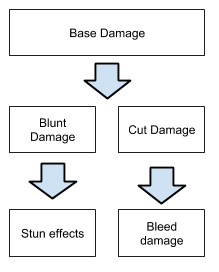Difference between revisions of "Battle Engine"
| Line 42: | Line 42: | ||
'''If a character is stunned the attacker has a 100% chance to hit the opponent.''' | '''If a character is stunned the attacker has a 100% chance to hit the opponent.''' | ||
| − | + | <u>Example:</u> | |
* Attacker has dex 20, defender has dex 15. Hit_Chance will be about 71%. | * Attacker has dex 20, defender has dex 15. Hit_Chance will be about 71%. | ||
| Line 81: | Line 81: | ||
Stun_Change = f( blunt_damage ) | Stun_Change = f( blunt_damage ) | ||
| − | Example: | + | <u>Example:</u> |
Attacker uses Fauchard. Base Damage = 10. Blunt Damage = 5. The defender is on the head, where the helmet has defense = 1. The final Blunt Damage will be 4 and the stun chance will be 2.67%. | Attacker uses Fauchard. Base Damage = 10. Blunt Damage = 5. The defender is on the head, where the helmet has defense = 1. The final Blunt Damage will be 4 and the stun chance will be 2.67%. | ||
| Line 106: | Line 106: | ||
Every successful hit will accumulate a certain amount bleed damage that depends from the weapon penetration. | Every successful hit will accumulate a certain amount bleed damage that depends from the weapon penetration. | ||
| − | Example | + | <u>Example:</u> |
Attacker uses Fauchard. Base Damage = 10. Cutting Damage = 5. | Attacker uses Fauchard. Base Damage = 10. Cutting Damage = 5. | ||
Revision as of 16:02, 4 November 2014
Contents[hide] |
Battle Engine Explained
Definitions
| Match | A complete fight between two characters. A match has n rounds. |
| Round | A round includes two turns, one for the attacker and one for defender |
| Turn | A turn may includes n (consecutive)=Battle Engine Explained= |
How it works
Initiative Computation
Initiative determine who will attack first and is computed at the start of every round. It will depend on the reach attribute of each character’s weapon. A character using a weapon with a longer reach than his/her opponent will have better odds of gaining the initiative. If the weapons have the same reach, each character has a equal chance of gaining the initiative.
Initiative = f( Attacker_Weapon_Length, Defender_Weapon_Length )
Consecutive Hits Computation
Range: 1-3
After initiative has been computed, the engine computer how many consecutive hits the attacker will deal. Consecutive hits are negatively affected by the attacking character’s weapon weight and weapon length, and positively affected by the attacking character’s strength and energy levels.
Stunned characters cannot attack.
Consecutive attacks number = f( Attacker_Weapon_Length, Strength, Energy )
Hit and Miss Chance Computation
Logic to hit or miss depends on the ratio between Attacker and Defender Dexterities.
Hit_chance = f( Attacker_Dexterity, Defender_Dexterity )
If a character is stunned the attacker has a 100% chance to hit the opponent.
Example:
- Attacker has dex 20, defender has dex 15. Hit_Chance will be about 71%.
- Attacker has dex 20, defender has dex 2. Hit_Chance will be about 97%.
- Attacker has dex 10, defender has dex 18. Hit_Chance will be about 55%.
- Attacker has dex 1, defender has dex 18. Hit_Chance will be about 26%.
Damage Computation
Dealt damage depends from the following factors:
- Weapon Damage
- Weapon Condition
- Strength
- Energy
- Defender AC
Base Damage
Base Damage = f ( Weapon_Damage, Weapon_Condition, Strength, Energy) + Strength / 6
The Base Damage is randomly selected within the range of damage values for the equipped weapon. With a Strength value of 10, an energy value of 50%, and a weapon condition of 50%, the damage will be randomly selected using a Normal (Gaussian) distribution centered on the mean of the weapon’s damage range. Thus, if the range is 1-7, a 4 will have the best odds of being rolled and a 1 and a 7 would have the worst odds of being rolled.
- With increasing Strength, Energy and Weapon Condition, the distribution is skewed more toward the maximum of the range.
- With decreasing Strength, Energy and Weapon Condition, the distribution is skewed more toward the minimum of the range.
The Base Damage is then partitioned in Blunt Damage and Cutting Damage accordingly to the weapon Cutting Damage/Blunt Damage. For example if the Base Damage with a Fauchard is 10, Blunt damage will be 5 and Cutting Damage 5. Check Weapons Table for useful data.
Blunt Damage
Blunt damage is the damage inflicted by the inertia of a weapon impacting an opponent. It depends from the choosen weapon. Blunt damage brings a chance to stun an opponent, which causes the character to:be unable to attack or defend. The chance of stunning an opponent is proportional to the amount of blunt damage inflicted.
Stun_Change = f( blunt_damage )
Example:
Attacker uses Fauchard. Base Damage = 10. Blunt Damage = 5. The defender is on the head, where the helmet has defense = 1. The final Blunt Damage will be 4 and the stun chance will be 2.67%.
Effects of stun
If a character is stunned, he can be stunned for n turns, where the number of turns for which the opponent is stunned depends on opponent constitution:
Rounds_stunned = f (constitution);
When the player is stunned:
- The player is unable to attack the opponent and to defend himself;
- All of the opponent’s attack swings are successfully dealt;
- Basic damage incurred from the opponent is increased by 150%
Cutting Damage
Cutting damage is the damage inflicted by the weapon slicing into flesh of an opponent. Cutting damage causes the initial damage but also bleed damage, which is inflicted each turn until the fight is concluded.
Effects of bleed damage:
Bleed damage is the damage caused by blood loss coming from a cutting wound. It is a percentage of the cumulative cutting damaged incurred. Every successful hit will accumulate a certain amount bleed damage that depends from the weapon penetration.
Example:
Attacker uses Fauchard. Base Damage = 10. Cutting Damage = 5.
Mario hits Paolo for 5 cutting damage. This will result in about 0.125 HP Bleed Damage. Paolo receives another hits and his Bleed Damage accumulates to 0.3 HP. At each turn Paolo will receive an additional damage of 0.3 HP.
The Critical Hit
Energy consumption
Energy is very important in battle (for example you see in the previous formula that impacts the number of consecutive hits). The energy consumed for each hit will depend on:
- Weapon weight;
- War encumbrance;
- Strength;
- Constitution;
Energy depleted for each attack = f( Weapon_Weight, War_Encumbrance, Strength ) Energy restored for each attack = f( Constitution )
War Encumbrance
War encumbrance is computed as follows:
War Encumberance = (Equipped items weight)/Base_Transportable_Weight
where
Base_transportable_weight = 100 - power(abs( strength - 20 ), 1.3) Kg


